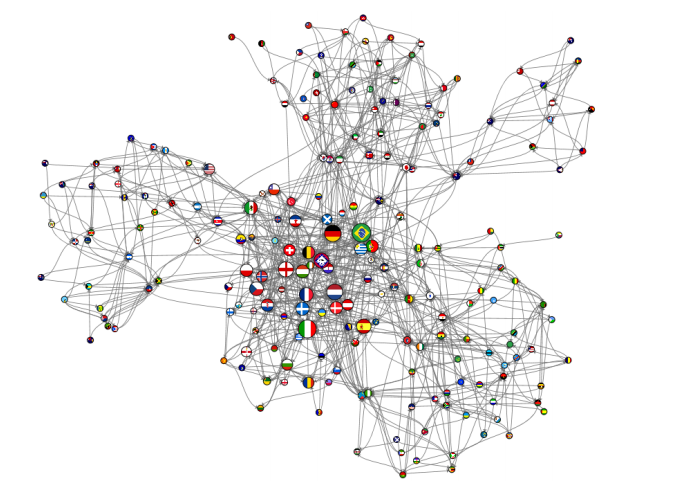Pagerank Algorithm Reveals World’s All-Time Top Soccer Team
Google’s Pagerank algorithm has become one of the most famous in computer science. It was originally designed to rank websites according to their importance by assuming that a site is important if it is linked to by other important sites.

The algorithm works by counting the links to a website and the importance of the sites these come from. It then uses this to work out the importance of the original site. Through a process of iteration, the algorithm comes up with a ranking.
Since Google’s founders, Larry Page and Sergei Brin, developed the algorithm in the mid-1990s, researchers have begun using it to rank nodes in other networks. One idea has been to use it to rank scientific papers using the network of links in the references they contain. Another is to use it for elections in which everyone is a candidate and can vote for anybody else.
Today, Verica Lazova and Lasko Basnarkov at Cyril and Methodius University in Macedonia have found another use for the Pagerank algorithm. These guys have used it to create an all-time ranking of the world’s national football teams using results from the 20 World Cup tournaments that have taken place since 1930. Their assumption is that a team should ranked highly if it has beaten other highly ranked teams.
The method is straightforward. They take the results of over 7000 games played between 210 countries since 1930. During these games, the teams scored over 20,000 goals at an average of 4.3 per game.
Lazova and Basnarkov go on to create a network in which teams are nodes and a link exists between them if they have played against each other. The weight and polarity of this link depends on the results, who has beaten who and so on.
Finally, they apply the Pagerank algorithm over a number of iterations to determine a ranking.
The results will be interesting reading for any soccer aficionado. The top ranked team is Brazil, which is hardly surprising given that it has won the tournament a record 5 times, more than any other nation. It has also played more games than any other team, won more games and scored more goals.
After Brazil come Italy, Germany, the Netherlands, Argentina, England, Spain, France and Czechoslovakia, in that order.
Lazova and Basnarkov then compare their ranking to the all-time list created by soccer’s international governing body, FIFA. This has Brazil at the top followed by Germany then Italy. Argentina is the 4th ranked team with Spain 5th and England 6th.
That’s similar to the Pagerank list but there are some striking differences too. The Netherlands are ranked 8th on Fifa’s list but 4th on the Pagerank list. Denmark is 17th on Pagerank’s list but only 25th on Fifa’s. And Czechoslovakia doesn’t appear at all on Fifa’s list, having ceased to exist as a country in 1993.
That’s an interesting approach that shows Pagerank’s utility in being able to rank the nodes in more or less any type of network. Clearly, the same approach could work for American football, baseball, basketball, cricket and more or less any other sport. If any computer scientist has some spare time to perform these rankings, he or she could win the hearts and minds of countless fans who will be eagerly awaiting the outcome of Pagerank’s ranking of their teams.
Ref: arxiv.org/abs/1503.01331 : PageRank Approach to Ranking National Football Teams
Keep Reading
Most Popular
Large language models can do jaw-dropping things. But nobody knows exactly why.
And that's a problem. Figuring it out is one of the biggest scientific puzzles of our time and a crucial step towards controlling more powerful future models.
The problem with plug-in hybrids? Their drivers.
Plug-in hybrids are often sold as a transition to EVs, but new data from Europe shows we’re still underestimating the emissions they produce.
Google DeepMind’s new generative model makes Super Mario–like games from scratch
Genie learns how to control games by watching hours and hours of video. It could help train next-gen robots too.
How scientists traced a mysterious covid case back to six toilets
When wastewater surveillance turns into a hunt for a single infected individual, the ethics get tricky.
Stay connected
Get the latest updates from
MIT Technology Review
Discover special offers, top stories, upcoming events, and more.